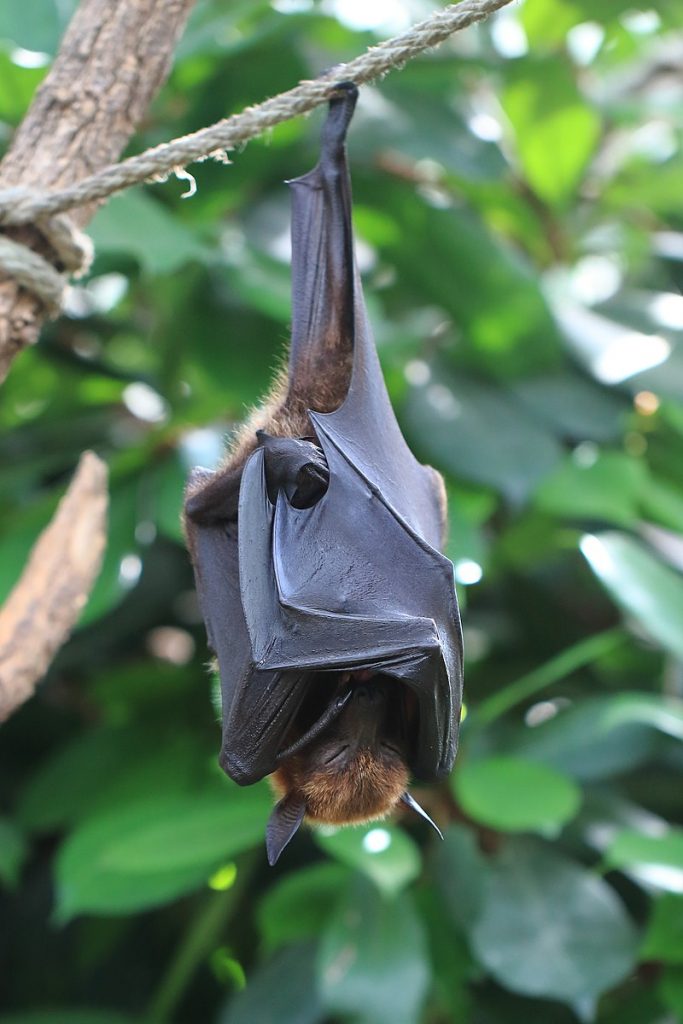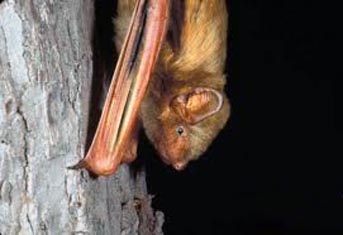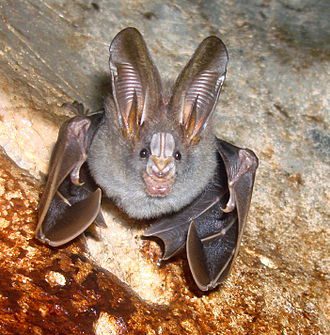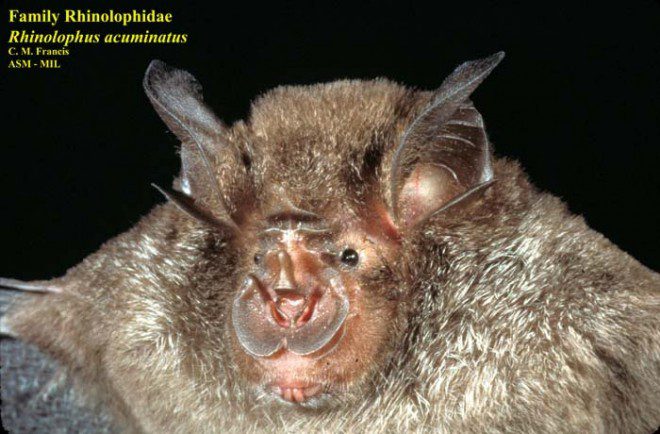Of the 216 recorder mammal species found in Cambodia, there are around 27 types of bat.
These winged and often strange looking mammals do a lot of good work eating bugs and spreading seeds and pollen.
CNE totally recommends Battambang for bats, with the colony of flying foxes in Wat Baydamram and the famous bat cave at Phnom Sampov. There is also the flying fox colony at Wat Phnom in the capital.
The lesser short-nosed fruit bat (Cynopterus brachyotis) is a species of small megabat that lives in South and Southeast Asia and Indonesia (Borneo). It weighs between 21 and 32 g. It occurs in many types of habitat, but most frequently in disturbed forest, including lower montane forest and tropical lowland rainforest, plus gardens, mangroves, and vegetation on beaches.

There are nine subspecies of lesser short-nosed fruit bat.
The lifespan of the lesser short-nosed fruit bat is approximately 20 to 30 years.
Lesser short-nosed fruit bats are frugivorous. They prefer aromatic fruit, especially mangoes. The bats feed mainly on small fruits by sucking out the juices and soft pulp. They also eat nectar and pollen.
Lesser short-nosed fruit bats prefer to roost in small groups in trees, under leaves, and in caves. Young males may roost alone. It is common for one male to roost with up to four females. Females may gather in groups of up to 20. To feed, the bats bite off the center part of palm fruit clusters, leaving a hollow for hanging, which is also the method they use to construct a shelter. Males may spend more than two months chewing the veins of leaves and palm fronds until they fall to form a shelter. Individuals use tactile, visual, and acoustic stimuli to communicate. They forage with their acute sense of smell and navigate with their keen vision.
Lesser short-nosed fruit bats are free of terrestrial predation because of their ability to fly. Some human cultures consume them as a delicacy. They play important roles in plant pollination. Plants such as bananas, avocados, dates, mangoes, peaches, and Agave tequilana depend on them for seed dispersal. The bats are considered to be crop pests since they consume and damage fruit.
Lesser short-nosed fruit bats are designated a least-concern species by the International Commission on Zoological Nomenclature (ICZN) because the population is widely distributed, stable and still abundant. Possible threats may be habitat loss due to development, dams, and deforestation. The animals are being hunted for medical purposes, as reported in ICZN 2006.
The greater short-nosed fruit bat or short-nosed Indian fruit bat (Cynopterus sphinx) is a species of megabat in the Pteropodidae family found in South and Southeast Asia.

These bats have a relatively long snout. Their upper parts are brown to grey-brown with paler under parts. The fur is very fine and silky. The ears and wing bones of C. sphinx are edged in white. Lower cheek teeth rounded without accessory cusps. The wing span of the adult is about 48 cm. Juveniles are lighter than adults. Average forearm length 70.2mm (64-79mm).
C. sphinx is common in tropical forests and areas where fruit crops are cultivated. They can also be found in grassland and mangrove forests. They typically nest high in palm trees. The bats chew the fronds of the palms to construct fairly simple tents. These bats are also known to construct tents by closely interweaving the leaves and twigs of creeping vines which cover buildings, but such nests are constructed only when palms are not available.
The species is gregarious, and typically roosts in same sex groups of 8-9 individuals. The sexes remain separate until the mating season, when group size increases. They are polygynous and it is usual for 6-10 males and 10-15 females to share palm frond tents during the breeding season. C. sphinx is the only non-primate species to show fellatio, which enhances copulation time in the species. Copulation by males is dorsoventral and the females lick the shaft or the base of the male’s penis, but not the glans which has already penetrated the vagina. While the females do this, the penis is not withdrawn and research has shown a positive relationship between length of the time that the penis is licked and the duration of copulation. Post copulation genital grooming has also been observed. Males stay with females for some time after mating, but later return to same sex groups.
The adult sex ratio is very female biased. Researchers attribute this to the relatively rapid maturation of females compared to males. In Central India, C. sphinx breeds twice per year. Females produce a single young at a time. Each half of the bicornate uterus functions during alternate breeding cycles. The first pregnancy cycle occurs from October through February/March. Mating occurs immediately postpartum, and a second offspring is born in July. Gestation period is about 3–5 months. In 72% of bats, the first pregnancy occurs in the right horn of the uterus. The corpus luteum in the right ovary persists for some time after the pregnancy and prevents ovulation from occurring in the right ovary during the second breeding cycle. This creates the pattern of alternate functioning of the two horns of the uterus. However, the corpus luteum in the left ovary does not persist until the beginning of the next breeding cycle. As yet, no reason has been found for the dominance of the right horn during the first breeding cycle. Newborn bats weigh about 13.5 g and have a wingspan of 24 cm. By the time of weaning at 4 weeks of age, young bats weigh 25 g and have wings spanning 36 cm. Female short-nosed fruit bats reach sexual maturity at 5–6 months of age, but males are not capable of breeding until they are a year old.
These bats are frugivorous, locate their preferred food items by scent. They have been described as voracious feeders, eating more than their body weight in food in one sitting. Some preferred fruits include ripe guava, banana, chikoo, dates and lychees.
Short-nosed fruit bats inflict serious damage on many fruit crops, and are considered pests. In addition, these bats are possible vectors for Japanese encephalitis, which is serious disease in humans. These bats are important dispersers of date palm seeds, and pollinate many night blooming flowers.
Lyle’s flying fox[(Pteropus lylei) is a species of flying fox in the family Pteropodidae. It is found in Cambodia, Thailand and Vietnam, with an outlying population in Yunnan, China. It faces persecution from farmers and it is killed for bushmeat in parts of its range. The International Union for Conservation of Nature has rated its conservation status as being “vulnerable”.

Lyle’s flying fox is a moderate-sized species. It has a long snout, large eyes, pointed ears and a fox-like face. The upper parts are mostly blackish apart from a broad collar of orange fur and sometimes a dark brown or yellowish-brown lower body. The wings are black or dark brown, while the underparts are dark brownish-black.
Lyle’s flying fox is endemic to the countries in southern Asia adjoining the Gulf of Thailand, its range extending from southern Thailand through central and southern Cambodia to the extreme southwestern part of Vietnam. It has also been detected in Yunnan Province in China. It is gregarious and roosts in tropical and sub-tropical forest, mangrove forests and can also occur in plantations and secondary forests.
A colony of thousands of bats consisting of this species, mixed with the large flying fox, is to be found at the Bat Pagoda (Khmer Chùa Dơi) in Sóc Trăng city in the Mekong Delta region of Vietnam. Here the bats roost in trees in the grounds of the temple and are protected by the monks.
Like other flying foxes, Lyle’s flying fox feeds on fruit; its diet is known to include mango, cashew, monkey jack, sapodilla, dragonfruit, Java apple, tamarind, jambolan and roseapple. The flying fox chews the fruit and spits out most of the seeds, but some seeds are swallowed and pass through the bat, resulting in their dispersal. The bat also feeds on flowers, nectar and pollen. While foraging they visit orchards, and may fly 50 km between roosts.
The bats feed nocturnally but the roosting colony, high in trees, is quite active during the day, with mothers feeding their young and the bats moving around and vocalizing. This bat is a reservoir for the Nipah virus, the causal agent of a newly emerged neurological and respiratory disease which was first reported in 1998. The virus is harmless in bats but can cause a fatal disease in pigs and humans.
The trees in which Lyle’s flying fox roosts may become denuded of leaves and the bats may be threatened when the trees die, if they have not been replaced by new plantings. Another threat the bats face is hunting in Thailand and Cambodia and persecution by farmers across their range trying to protect their orchards. The International Union for Conservation of Nature estimates that populations have declined by more than 30% within the last fifteen years and has rated the conservation status of this flying fox as “vulnerable”.
The large flying fox (Pteropus vampyrus), also known as the greater flying fox, Malayan flying fox, Malaysian flying fox, large fruit bat, kalang or kalong, is a southeast Asian species of megabat in the family Pteropodidae.

Like the other members of the genus Pteropus, or the Old World fruit bats, it feeds exclusively on fruits, nectar and flowers (despite its scientific name). It is noted for being one of the largest bats. It, as with all other Old World fruit bats, lacks the ability to echolocate, but compensates for it with well-developed eyesight.
The large flying fox is among the largest species of bat. It weighs 0.65 – 1.1 kg and has a wingspan of up to 1.5 m. As with all megabats, it has a fox-like face, hence its name. It lacks a tail and has pointed ears. The hairs on much of its body are long and wooly, but are shorter and more erect on the upper back. The mantle hairs tend to be the longest. The color and texture of the coat differ between sexes and age classes. Males tend to have slightly stiffer and thicker coats than females. Immature individuals are almost all dull gray-brown.Young have a dark-colored mantle that becomes lighter in males when they mature. The large flying fox’s wings are short and somewhat rounded at the tips. This allows them to fly slowly, but with great maneuverability. The wing membranes are only haired near the body.
The large flying fox ranges from Malay Peninsula, to the Philippines in the east and Sumatra, Java, Borneo and Timor in the south. In certain areas, the bat prefers coastal regions, but it can also be found at elevations up to 1370 m.
Flying foxes inhabit primary forest, mangrove forest, coconut groves, mixed fruit orchards, and a number of other habitats. During the day, trees in mangrove forests and coconut groves may be used as roosts.
This species primarily feeds on flower, nectar and fruit. When all three food items are available, flowers and nectar are preferred. The pollen, nectar, and flower of coconut and durian trees, as well as the fruits of rambutan, fig and langsat trees, are consumed. Flying foxes will also eat mangoes and bananas.
With fruit, the flying fox prefers the pulp, and slices open the rind to get it. With durian tree flowers, the flying fox can lick up the nectar without doing apparent damage to the flower.
Colonies of large flying foxes fly in a scattered stream. They may fly to their feeding grounds for up to 50 km in one night. Vocalizations are not made during flight. Large flocks fuse into family or feeding groups upon arrival at feeding grounds. Flying foxes may circle a fruit tree before landing, and usually land on the tips of branches in an upright position, then fall into a head-down position from which they feed. Feeding aggregations tend to be very noisy.
Flowering trees form the basis of territories in this species. Territoral behavior includes growling and the spreading of wings. A roosting flying fox is positioned upside down with its wings wrapped up. When it gets too warm, a flying fox fans itself with its wings. Roosting bats are restless until midmorning.
A recent update by the IUCN has listed the species as Near Threatened.
One threat to the large flying fox is habitat destruction. Flying foxes are sometimes hunted for food, and the controls on hunting seem to be unenforceable. In some areas, farmers consider them pests as they sometimes feed on their orchards.
Geoffroy’s rousette (Rousettus amplexicaudatus) is a species of megabat or Old Worldfruit bats. It is one of 10 species in the genus Rousettus.

Geoffroy’s rousettes are found in subtropical and tropical areas. They prefer lower elevations near coasts. These bats roost in large limestone caves near primary or secondary forests. These caves are never far from human habitation, and plantations are often nearby.
They roost in large numbers with more than 2,000 bats at a roost. A roosting site of 1.8 million individuals has been observed (in the Philippines), however, this large group might be due mostly to their small area of protected habitat.
Geoffroy’s rousettes have brown or grey-brown bodies, their heads are usually darker than their underparts. Their fur is short, with longer, sometimes yellow hairs around their neck and chin, most commonly seen in males. Males of this species are much larger than females. They vary in forearm length from 82.22 -86.76 mm, the length of their bodies range from 78 to 87 mm.
Geoffroy’s rousettes have been known to travel up to 25 km from roost sites to foraging sites. These bats also fly over water barriers and agricultural areas to reach their foraging and roosting sites.
Rousettus is the only genus of echolocating Old World fruit bats. They produce sonar clicks with their tongue; their clicks are extremely short at about 50 to 100 microseconds per click.
Geoffroy’s rousettes consume nectar and pollen. When in season, these bats also feed on soft ripe fruit, usually in orchards. Geoffroy’s rousettes have been known to fly more than 38 km to forage for food in a single night. They form large groups when feeding upon large areas of food, such as orchards or groups of fig trees.
Geoffroy’s rousettes are often hunted for food, and their guano is collected as a delicacy in many native tribes. Both of these collections can be used as a form of cash crop or as trade and barter items.
Leschenault’s rousette (Rousettus leschenaultii) is another species of fruit bat.

Leschenault’s rousette is brown to grey-brown in colour with lighter underparts. It has long pale hairs under the chin, an elongated muzzle and large dark eyes. The head and body length measures 9.5–12 cm, the tail length measures 1–1.8 cm and the forearm length is about 7.5–8.5 cm.
This bat species is found in a variety of habitats ranging from tropical forests to urban environments. It roosts in caves, old abandoned buildings and tunnels, and other such structures. A colony of this animal can contain up to several thousand individuals. It feeds on fruits, nectar and flowers.
The lesser large-footed bat (Myotis hasseltii) is a species of vesper bat. It can be found in Cambodia, India, Indonesia, Malaysia, Myanmar, Sri Lanka, Thailand, and Vietnam.

Head and body length is 6cm, forearm 4cm.
Grayish brown above and yellowish white below. Muzzle is blunt with face in front of the eyes are almost naked. Ears short. Wing membrane dark blackish brown. Very short and dense fur. Long feet.
Myotis hasseltii, variously known as the brown bat, Van Hasselt’s bat, Van Hasselt’s mouse-eared bat, or lesser largefooted myotis is reported to roost alone or in small groups in bamboo clumps, cracks in tree bark, and in abandoned buildings. Mangrove swamps are another possible habitat for these bats. M. hasseltii likes living near water and flies low over streams, tanks (reservoirs), and mangrove swamps hunting for gnats, small flies, and mosquitoes.
The wall-roosting mouse-eared bat, or Nepalese whiskered myotis (Myotis muricola)

M.muricola is found in Afghanistan, Bangladesh, Bhutan, Cambodia, India, Indonesia, Laos, Malaysia, Myanmar, Nepal, Pakistan, Papua New Guinea, the Philippines, Thailand, and Vietnam.
M.muricola is a nocturnal and insectivorous bat. It tends to feed during the first two hours after sunset and before dawn, using ultrasonic echolocation. It catches insects in flight or perched on foliage, the ground or a water surface. Small insects are usually caught directly in the mouth, while larger ones are scooped out of the air using the tail membrane and flipped into the mouth, or brought to the mouth with the wing tips . It drinks by swooping low over the surface of a body of water or collecting droplets of water from the roof of tunnels or caves in which it roosts.
M.muricola roosts in a variety of different sites, including curled-up banana leaves, limestone forests, hollow trees, rock shelters, artificial caves, mines and tunnels, and old buildings.
According to the 2008 IUCN Red List of Threatened Species, M.muricola is classified as Least Concern.
Tickell’s bat (Hesperoptenus tickelli) is a species of vesper bat. It can be found in the following countries: Bhutan, Cambodia, possibly China, India, Myanmar, Nepal, Sri Lanka and Thailand.

Head and body length is 7cm. Forearm 5-6cm. Wingspan 38-41cm.
In South Asia, this species roosts solitary or in small groups of a few individuals among dense canopied trees. It is found in lowlands, hills and near seashore.The species forages in open areas among paddy fields, grasslands, with a steady and slow flight, and mostly feeds on beetles, termites and other insects. A single young is born in May.
In Southeast Asia, it is considered to be a forest edge species that can be found close to degraded areas (such as agricultural land). They usually appear early, flying low and steadily, wheeling in large circles.
The black-bearded tomb bat (Taphozous melanopogon) is a species of sac-winged bat. It is found in South and South East Asia.

Black-bearded tomb bats are found in habitats including rainforests, woodlands, tombs, deserted buildings, rock formations, caverns, cliffs, and arid country plains. They prefer densely sheltered areas. They roost in groups ranging from 200 to 4000 individuals.
The coat of black-bearded tomb bats is quite variable dependent on its particular environment. It ranges from grayish to multi-brown or red variations.
Males have a black beard, which is believed to be seasonal. In the mating season, males produce a thick substance into the beard that is believed to be a form of pheromone to attract mate. The thick tail tapers to a slightly bulbous tip. The wings attach just above the ankles.
These bats are strong fliers that can reach recorded heights of 90 meters.
Within roosts males have been known to form a protective circle around the female and young. Each male has a particular area, which it occupies; this implies a social hierarchy in the colonies. In some cases there are strictly male or female colonies found in roosts (mainly after the mating season). These bats tend to scream a very piercing, high-pitched noise when being captured, in danger, or injured.
Taphozous melanopogon feeds primarily on flying insects, although it also sometimes feeds on small fruits. It hunts by echolocation, emitting a “click” or “tic” that can be faintly audible to humans.
The lesser false vampire bat (Megaderma spasma) is a bat found in South Asia and Southeast Asia from Sri Lanka and India in the west to Indonesia and the Philippines in the east. They live in caves and tree hollows. They are insectivorous.

The lesser false vampire bat has a wingspan of up to 30 centimetresand have a head-and-body length of around 10 centimetres. Their forearms are normally around 7 centimetres (2.8 in).
The lesser false vampire bat has yellowish veins through the wing, and when the wings are spread with light behind, they are given a prominent yellow/orange tinge. Their body colour ranges from grey-brown to blue-brown. Lesser false vampire bats live in rock crevices, caves, foliage and hollow trees, depending on availability, as well as hanging and sleeping on trees in general.
M. spasma has fur pale grey to grey-brown in colour.[6] Its noseleaf has long dorsal lobe with stiffened central ridge and broad convex flaps on the sides. Its ears are very large, joined at the base and it has no visible tail. Its echolocation pulses are short, low in density and broadband and its large ears are sensitive to echoes returning from their pulses and also sensitive to the sounds that prey generates.
M. spasmausually roosts in groups in caves, pits, building, and hollow trees. M. spasmafavours grasshoppers and moths, but sometimes they eat small vertebrates including other bats. They have well developed, forward-pointing eyes and can locate prey visually.[
M. spasma usually roosts in a group of 3–30 individuals. Their ecological importance may be both positive and negative to humans. They eat some insects which harm human crops, but they may carry and transmit certain diseases.
The acuminate horseshoe bat (Rhinolophus acuminatus) is one of five species of bats in the family Rhinolophidae found in Cambodia and Thailand. It lives in forests and urban areas.

Its forearm length is 48–50 mm; its tail length is 21–31 mm ; its ear length is 20–21 mm. It weighs 11.5–13.5 g.
It is nocturnal, roosting in sheltered places during the day such as inside caves or on the undersides of palm leaves. It roosts in small colonies.
It is currently evaluated as least concern by the IUCN—its lowest conservation priority. It meets the criteria for this assessment because it is a widespread species considered locally common.
The intermediate roundleaf bat (Hipposideros larvatus) is a species of bat in the family Hipposideridae.

The intermediate leaf-nosed bat is widespread in Asia.
Hipposideros larvatus typically roosts in caves. But they also roost in abandoned mines, rock crevices, mines shafts, pagodas, buildings, and tropical moist forest. It is also found roosting in human habitations. Roosts may contain several hundred bats of both sexes. And H. larvatus often shares their roost with other bat species. This species is primarily found at altitudes from 182 to 860 meters.
There are several diagnostic features of the intermediate roundleaf bat and they are: the three lateral accessory leaflets on each side of the noseleaf, dark grey-brown or reddish brown fur color (dorsal fur is a uniform cinnamon brown, while the ventral fur is lighter grey), dark grey or brown ears and noseleaf, broad and triangular shaped ears, and that juveniles are darker than adults. The average forearm length is about 55.5-62.2mm. With an average body mass of 17.4 – 24.8g. Its ear length is around 17–22 mm.
The major diet for H. larvatus consist mainly of beetles. But it also eats moths, butterflies, flies, mosquitoes, termites, insects from the Hemiptera order, caddisfly, sawfly, ants, wasps, spiders, mites, and ticks.
This particular species of bats emit an average resting frequency (RF) of 85 kHz.
More mammal species here: https://cne.wtf/2019/06/26/cambodian-critters-part-one-the-furries/

Very interesting article. In England, I don’t remember seeing more than a few budgie-sized bats so to read here about the bat with a 5-foot wingspan is like – Wow! Keep up the good work.